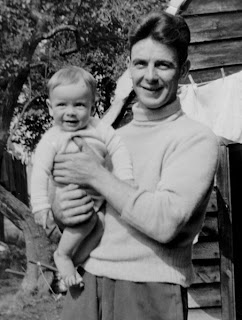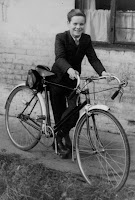
My father died in 1996 and it is not unusual that I would be thinking of him at this time as today was his birthday.
I am who I am today because of my father. Because of him I got into cycling and later racing, which led to framebuilding. Therefore, if not for my father I would never have built frames and would not be writing a bicycle blog.
For most of my early years he was gone. Called into the British army at the start of WWII, was gone for almost five years, and then came home briefly before going away again as part of the Normandy Invasion. I was nine years old when the war ended and he came home for good.
The only existing pictures of my father and me together are baby pictures like the one above. I can’t help thinking how proud he looks holding his infant son. Later our relationship would degenerate into mutual feelings that would vary somewhere between a strong dislike and deep hatred.
He was a cruel, sadistic man who one time stubbed a lighted cigarette on the back of my hand, just because he though it funny. He was an ex-amateur boxer, and wanted me to take up the sport.
At age, 11 he would have me jump rope for an hour at a time. We would put on boxing gloves and he would spar with me; invariably he would become angry when I didn’t do as he showed me, and would punch me real hard. I was knocked unconscious on several occasions.
My father never owned a car or learned to drive; a bicycle was his only transport to get to work each day. I will say one thing for my father he worked extremely hard; if he lost a job he would find another very quickly. He was a laborer with very few skills and worked a series of back-breaking, hard, menial jobs.
 At times he worked long hours and made good money. He was generous with his money; incapable of showing love, I think he gave money away in lieu of affection. I was age 13 when he bought me my first brand new bike; it was a Hercules Roadster.
At times he worked long hours and made good money. He was generous with his money; incapable of showing love, I think he gave money away in lieu of affection. I was age 13 when he bought me my first brand new bike; it was a Hercules Roadster.
Not one piece of aluminum on this bike, even the mudguards were steel; it had a three-speed hub gear, and must have weighed 40lbs.
This bicycle became my escape from the torment at home. I had school friends who lived as far as 15 or 20 miles away and I would ride over to spend an evening with them, often it meant riding home after dark.
Weekends it was not unusual for me to ride 100 miles on my own. I can remember getting severe bouts of the bonk, (running out of fuel) and knocking on a stranger’s door to ask for food.
At age 15 I was attending a technical school, learning engineering. The school building was part of a complex that included a community college. Some of the older students that attended the college owned racing bikes with names like, Paris, Hobbs of Barbican, and Claud Butler. At every opportunity I would be drooling over these bikes; it was the start of a love affair that still lasts to this day.
My father came through again and bought me a modest Dawes lightweight, with a four speed Simplex derailleur. I joined a cycling club and started racing at age 16. With all the miles I had done over the years I did well and won a few club level races, and for the first time in my life people were telling me I was good at something.
Even my father showed some interest as long as I was winning, but when I didn’t he would tell me I was useless. More than anything, I wanted him to come out and see me race; but he never did.
At age 16 I began work as an engineering apprentice, and rode my bike to work every day. I arrived home one day and my mother told me my father had been involved in a serious accident at work.
He worked in an iron foundry at the time, and he and another man opened the door of the blast furnace. There was what is known as a blow back, and the two of them were completely buried in hot coals. Coworkers pulled them out immediately but they were seriously burned from head to toe.
My immediate thought was, “I hope the bastard dies.” Then I quickly saw my mother’s concern, and realized for the first time that she truly loved him. I had always assumed her feelings for him were the same as mine. My mother, who also suffered abuse, would constantly vent her frustrations over my father, with me. A form of emotional incest that was her only relief, but constantly fueled my hatred for the man.
I went to visit him at the hospital; it was a surreal experience. I saw a large piece of featureless blackened raw meat sitting up in bed; the eyes and the voice were all I could recognize, and a cigarette, stark white by contrast, sticking out were a mouth should be.
This was a day after the accident and I can only imagine the tremendous pain he must been in. But you never would have known it as he casually talked to me as if nothing had happened. To show pain would have been to show emotion and a perceived weakness. He was left with bad scars on his arms and body, but his face healed completely unscarred.
I left home at age 19 and a few years later moved away. After that I never saw my father for 25 years. I was living in California and sometime after my mother died in 1982 I wrote to him. I tried to come to terms with our relationship but later when I visited with him, the hatred and nastiness on his part was still there.
We talked about my childhood and he could not accept that he had done anything wrong, let alone ask for, or accept forgiveness. I had to wait until after his death to finally forgive him. Forgiveness is more for the sake of those sinned against, than for the sinner.
In 1996 he went for routine surgery for a bladder problem; there were complications and he had a second operation. His heart gave out under the anesthetic; he was 86. A good age considering the alcohol and tobacco abuse he had put his body through during his life.
If there can be a defense for this man, who was after all human with human weaknesses. Like many others, he went through almost six years of hell during WWII, killing people, witnessing death on a daily basis. Then was expected to come home and live a normal life. He never talked of his own childhood, but I’m sure it was bad.
I often wonder what if my father had been killed in the war; I never would have known him. I would have these pictures of this handsome man, and my mother would have no doubt told me wonderful stories about him. I would have spent my entire life trying to live up to the image of a man far greater than he could ever be in real life. Would I have turned out any better, or worse?
My father really thought that what he did was for my own good; and maybe in a way he was right; I am happy with who I turned out to be. I would not wish my childhood on anyone, but having said that I would not change a thing either.
I got through it, I survived, and maybe I’m a stronger person because of it. My childhood and my father are long gone, and anyway I realized a long time ago that no matter how hard I try, the past will never get any better.
 Sun, December 24, 2006
Sun, December 24, 2006  I have been asked that question since I started posting pictures of my bike on this blog.
I have been asked that question since I started posting pictures of my bike on this blog.  You can see this in the picture of me, circa 1953.
You can see this in the picture of me, circa 1953.  The picture on the right is of a Huret front derailleur that was very popular in the 1950s.
The picture on the right is of a Huret front derailleur that was very popular in the 1950s.  Dave Moulton | Comments Off |
Dave Moulton | Comments Off | 


















